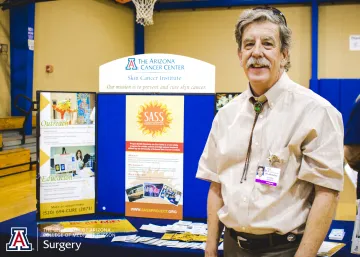Skin Cancer: Not Just a Summer Concern
As fall arrives and the days become cooler, many of us may be spending more time outside. Add to the cooler weather the fact that the COVID-19 pandemic limits our leisure activities, and hiking, biking, or otherwise spending time outdoors becomes even more appealing this fall season.

But just because the days are shorter and it’s not as hot out doesn’t mean we shouldn’t still be taking measures to protect ourselves from exposure to the sun and its potential health consequences, such as melanoma and other types of skin cancers.
‘don’t just take the heat as a barometer, urges Dr. James Warneke, one of the surgical oncologists with the University of Arizona Department of Surgery (DoS) and a member of the UAZ Cancer Center (UAZCC) Skin Cancer Institute (SCI). Instead, consider the intensity of the sun.
In fact, Tucson, AZ, is one of the global leaders in skin cancer cases, second only to Sydney, Australia. Even if you don’t live in Tucson, skin cancer is still a concern. It’s the most commonly diagnosed type of cancer, affecting 1 in 5 Americans in their lifetimes. 3.5 million new cases will be diagnosed this year alone. (Source)
There are two general categories of skin cancer: nonmelanoma skin cancer, consisting primarily of basal cell carcinoma and squamous cell carcinoma, and melanoma. While nonmelanoma skin cancers are much more common, melanoma is more serious and deadly. It’s estimated that nearly 100,000 people will be diagnosed with melanoma and more than 7,000 people will die from the disease in 2020. Unfortunately, the disease is a worsening problem, with cases steadily rising for more than three decades and incidence of diagnosis increasing about 3% annually. The UAZCC sees about 500 patients with melanoma on its surgical service each year.
In short, skin cancer is a disease that could affect any of us and continues to affect more and more of us.
The good news is that skin cancer treatment options are more advanced and varied than ever before. Melanoma in particular has seen a flurry of research activity and significant progress in treatment agents just within the last decade, especially in the area of immunotherapy. While surgery is still the primary treatment method for melanoma, Dr. Warneke says that surgical treatment has advanced significantly in that surgeons now have more nuanced ways of determining which patients need surgery immediately and which can hold off and simply be monitored for worsening symptoms. He adds that the outlook for melanoma patients has gotten much brighter; while a few years ago the average 5-year survival rate for the disease was only seven months, now it’s increased to more than two years.

However, by far the best form of treatment for melanoma is still prevention. That’s the mission of the Skin Cancer Institute, a group of medical and research specialists within the UAZ Cancer Center dedicated to skin cancer care and prevention. Along with helping to fund skin-cancer-related research and being highly active in clinical care, the institute supports many outreach and educational activities around the Southern Arizona community to warn people of the dangers of skin cancer and the best ways to protect themselves. For example, last year Dr. Warneke went to the Boys and Girls Club of Southern Arizona to teach kids about skin cancer prevention and provide sunscreen, information on how to perform self-checks, and other resources.
Unfortunately, the current COVID situation has made it difficult for the SCI to conduct their outreach activities in-person. The institute usually hosts an annual Melanoma Walk fundraiser to support their clinical, research, and educational activities, but had to cancel this year to ensure the community’s safety. That doesn’t mean the SCI’s activities are slowing down, however; the institute decided just to bring them online instead. Those interested in donating can visit: https://crowdfund.arizona.edu/project/21476.
?Just because we‘re all focused on COVID-19 doesn’t mean skin cancer isn’t still there, said Dr. Warneke. We‘re actively treating patients, and we still need to educate people and continue moving forward with research that helps us find better treatments.
So how does one prevent skin cancer? Dr. Warneke offers the following advice:
- Avoid peak hours. If you can help it, don’t spend too much time outside in the sun between the hours of 10 AM and 4 PM, when the sun’s rays are the strongest.
- Cover up. If you‘re going to be outside, especially during peak hours, protect your skin with long sleeves and a wide-brimmed hat. The good news is that these clothes are perfect for the cooler weather!
- Wear sunscreen. Before you go outside, apply sunscreen (at least SPF 30) to any areas exposed to the sun. Swimming or sweating? Re-apply every 40-80 minutes.
We don’t have to shelter altogether, Dr. Warneke says. ?But we should be smart.

